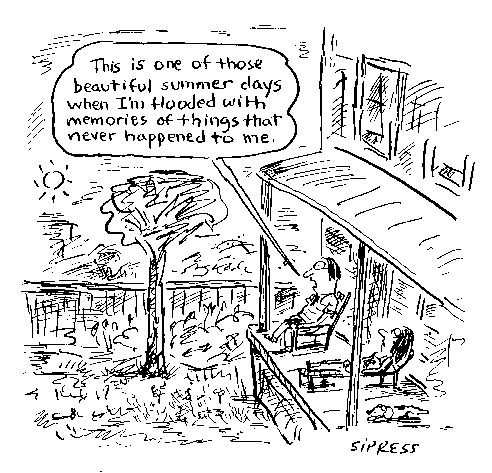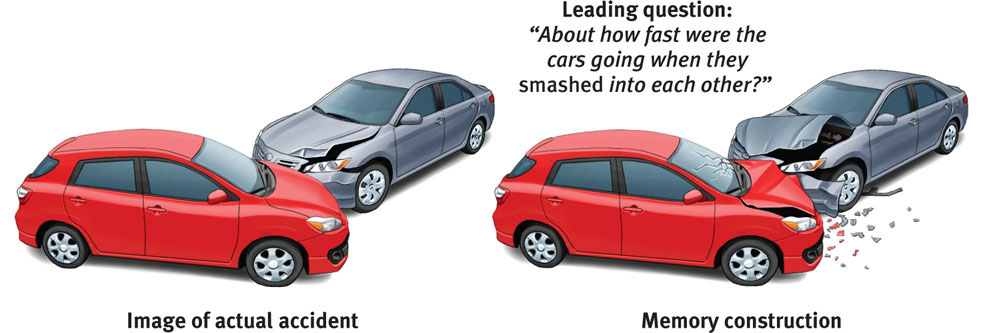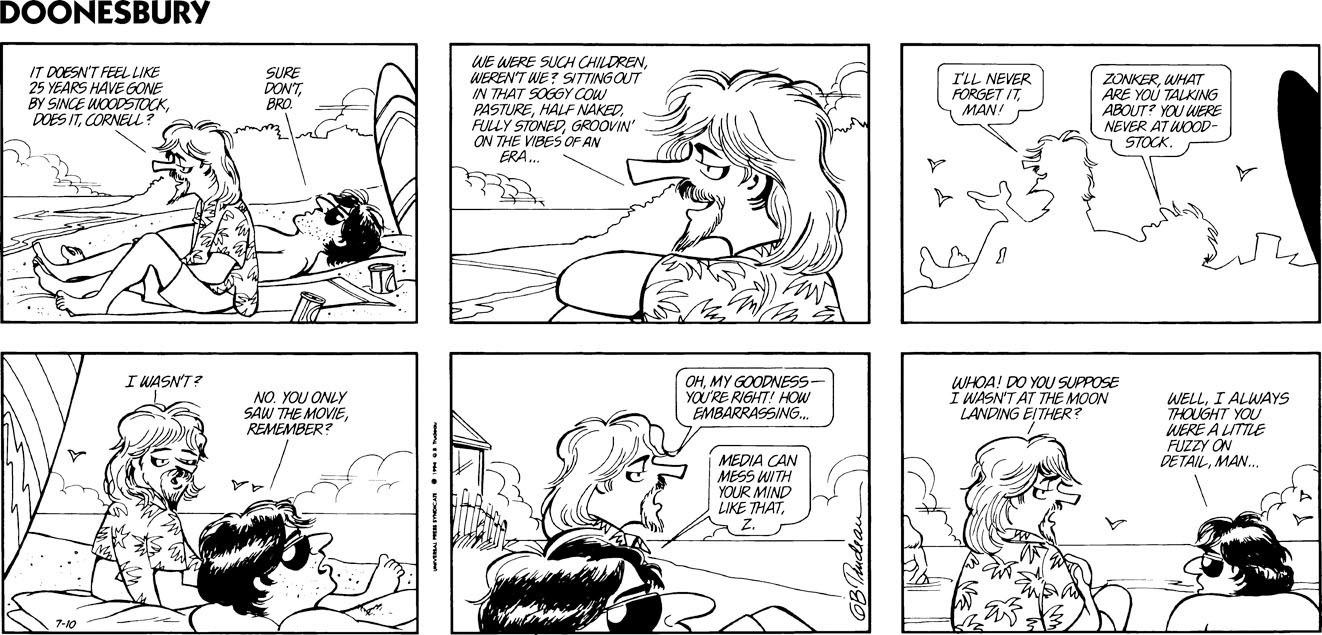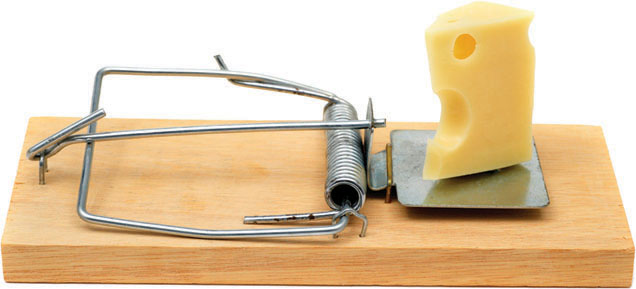Memory Construction Errors
7-17 How do misinformation, imagination, and source amnesia influence our memory construction? How do we decide whether a memory is real or false?

 Memory is not exact. Like scientists who infer a dinosaur’s appearance from its remains, we infer our past from stored tidbits of information plus what we later imagined, expected, saw, and heard. We don’t just retrieve memories; we reweave them (Gilbert, 2006). And every time we “replay” a memory, we replace the original with a slightly modified version (Hardt et al., 2010). (Memory researchers call this reconsolidation.) So, in a sense, said Joseph LeDoux (2009), “your memory is only as good as your last memory. The fewer times you use it, the more [unchanged] it is.” This means that, to some degree, all memory is false (Bernstein & Loftus, 2009).
Memory is not exact. Like scientists who infer a dinosaur’s appearance from its remains, we infer our past from stored tidbits of information plus what we later imagined, expected, saw, and heard. We don’t just retrieve memories; we reweave them (Gilbert, 2006). And every time we “replay” a memory, we replace the original with a slightly modified version (Hardt et al., 2010). (Memory researchers call this reconsolidation.) So, in a sense, said Joseph LeDoux (2009), “your memory is only as good as your last memory. The fewer times you use it, the more [unchanged] it is.” This means that, to some degree, all memory is false (Bernstein & Loftus, 2009).
210
Despite knowing all this, I recently rewrote my own past. It happened at an international conference, where memory researcher Elizabeth Loftus (2012) was demonstrating how memory works. Loftus showed us a handful of individual faces that we were later to identify, as if in a police lineup. Later, she showed us some pairs of faces, one face we had seen earlier and one we had not, and asked us to identify the one we had seen. But one pair she had slipped in included two new faces, one of which was rather like a face we had seen earlier. Most of us understandably but wrongly identified this face as one we had previously seen. To climax the demonstration, when she showed us the originally seen face and the previously chosen wrong face, most of us picked the wrong face! As a result of our memory reconsolidation, we—an audience of psychologists who should have known better—had replaced the original memory with a false memory.
How do we do it? How do we so easily rewrite our own history? Some memory research findings offer some clues.
Misinformation and Imagination Effects
In more than 200 experiments involving more than 20,000 people, Loftus has shown how eyewitnesses reconstruct their memories when questioned after a crime or an accident. In one study, two groups of people watched a film of a traffic accident and then answered questions about what they had seen (Loftus & Palmer, 1974). Those asked, “About how fast were the cars going when they smashed into each other?” gave higher speed estimates than those asked, “About how fast were the cars going when they hit each other?” A week later, when asked whether they recalled seeing any broken glass, people who had heard smashed in the leading (suggestive) version of the question were more than twice as likely to report seeing glass fragments (FIGURE 7.18). In fact, the film showed no broken glass.

In many follow-up experiments around the world, others have witnessed an event. Then they have received or not received misleading information about it. And then they have taken a memory test. The repeated result is a misinformation effect. Exposed to misleading information, we tend to misremember (Loftus et al., 1992). Coke cans become peanut cans. Breakfast cereal becomes eggs. A clean-shaven man morphs into a man with a mustache.
“Memory is insubstantial. Things keep replacing it. Your batch of snapshots will both fix and ruin your memory…. You can’t remember anything from your trip except the wretched collection of snapshots.”
Annie Dillard, “To Fashion a Text,” 1988
Just hearing a vivid retelling of an event may implant false memories. One experiment falsely suggested to some Dutch university students that, as children, they had become ill after eating spoiled egg salad (Geraerts et al., 2008). After absorbing that suggestion, they were less likely to eat egg-salad sandwiches, both immediately and four months later.

Even repeatedly imagining fake actions and events can create false memories. American and British university students were asked to imagine certain childhood events, such as breaking a window with their hand or having a skin sample removed from a finger. One in four of them later recalled the imagined event as something that had really happened (Garry et al., 1996; Mazzoni & Memon, 2003).
Should we be surprised that digitally altered photos have produced the same result? In experiments, researchers have altered photos from a family album to show some family members taking a hot-air balloon ride. After viewing these photos (rather than photos showing just the balloon), children “remembered” the faked experience. And days later, they reported even richer details of their false memories (Strange et al., 2008; Wade et al., 2002).
In British and Canadian university surveys, nearly one-fourth of students have reported personal memories that they later realized were not accurate (Mazzoni et al., 2010). I empathize. For decades, my cherished earliest memory was of my parents getting off the bus and walking to our house, bringing my baby brother home from the hospital. When, in middle age, I shared that memory with my father, he assured me they did not bring their newborn home on the Seattle Transit System. The human mind, it seems, comes with built-in Photoshopping software.
211
Source Amnesia
Among the frailest parts of a memory is its source. Have you ever recognized someone but had no idea where you had met the person? Or dreamed about an event and later wondered whether it really happened? Or misrecalled how you learned about something (Henkel et al., 2000)? If so, you experienced source amnesia—you retained the memory of the event but not of its context. Source amnesia, along with the misinformation effect, is at the heart of many false memories. Authors and songwriters sometimes suffer from it. They think an idea came from their own creative imagination, when in fact they are unintentionally plagiarizing something they earlier read or heard.
“Do you ever get that strange feeling of vujà dé? Not déjà vu; vujà dé. It’s the distinct sense that, somehow, something just happened that has never happened before. Nothing seems familiar. And then suddenly the feeling is gone. Vujà dé.”
Comedian George Carlin (1937–2008), Funny Times, December 2001
Psychologist Donald Thompson became part of his own research on memory distortion when police brought him in for questioning about a rape. Although he was a near-perfect match to the victim’s memory of the rapist, Thompson had an airtight alibi. Just before the rape occurred, he was being interviewed on live TV and could not possibly have made it to the crime scene. Then it came to light that the victim had been watching the interview—ironically about face recognition—and had experienced source amnesia. She had confused her memories of Thompson with those of the rapist (Schacter, 1996).
Source amnesia also helps explain déjà vu(French for “already seen”). Two-thirds of us have experienced this fleeting, eerie sense that “I’ve been in this exact situation before.” It happens most commonly to well-educated, imaginative young adults, especially when tired or stressed (Brown, 2003, 2004; McAneny, 1996). Some wonder, “How could I recognize a situation I’m experiencing for the first time?” Others may think of reincarnation (“I must have experienced this in a previous life”) or precognition (“I viewed this scene in my mind before experiencing it”).

The key to déjà vu seems to be that we are familiar with a stimulus or one like it but can’t recall where we ran into it before (Cleary, 2008). Normally, we experience a feeling of familiarity (thanks to temporal lobe processing) before we consciously remember details (thanks to hippocampus and frontal lobe processing). Sometimes, though, we may have a feeling of familiarity without conscious recall. As our amazing brain tries to make sense of this source amnesia, we get an eerie feeling that we’re reliving some earlier part of our life.
Recognizing False Memories
We often are confident of our inaccurate memories. Because the misinformation effect and source amnesia happen outside our awareness, it is hard to sift false memories from real ones (Schooler et al., 1986). Perhaps you can recall describing a childhood experience to a friend and filling in memory gaps with reasonable guesses. We all do it. After more retellings, those guessed details—now absorbed into your memory—may feel as real as if you had actually observed them (Roediger et al., 1993). False memories, like fake jewelry, seem so real.
212
False memories can be very persistent. Imagine that I were to read aloud a list of words such as candy, sugar, honey, and taste. Later, I ask you to recognize those words in a larger list. If you are at all like the people in a famous experiment (Roediger & McDermott, 1995), you would err three out of four times—by falsely remembering a new but similar word, such as sweet. We more easily remember the gist—the general idea—than the words themselves.
Memory construction errors can help us understand why some people have been sent to prison for crimes they never committed. Of 200 people who were later proven not guilty by DNA testing, 79 percent had been convicted because of faulty eyewitness identification (Garrett, 2008). “Hypnotically refreshed” memories of crimes often contain similar errors. If a hypnotist asks leading questions (“Did you hear loud noises?”), witnesses may weave that false information into their memory of the event.
Children’s Eyewitness Recall
7-18 How reliable are young children’s eyewitness descriptions, and why are reports of repressed and recovered memories so hotly debated?
If memories can be sincere, yet sincerely wrong, how can jurors decide cases in which children’s memories of sexual abuse are the only evidence?
Stephen Ceci (1993) thinks “it would be truly awful to ever lose sight of the enormity of child abuse.” Yet Ceci and Maggie Bruck’s (1993, 1995) studies have made them aware of how easily children’s memories can be molded. For example, they asked 3-year-olds to show on anatomically correct dolls where a pediatrician had touched them. Of the children who had not received genital examinations, 55 percent pointed to either genital or anal areas.
In other experiments, the researchers studied the effect of suggestive interviewing techniques (Bruck & Ceci, 1999, 2004). In one study, children chose a card from a deck of possible happenings, and an adult then read the card to them. For example, “Think real hard, and tell me if this ever happened to you. Can you remember going to the hospital with a mousetrap on your finger?” In weekly interviews, the same adult repeatedly asked children to think about several real and fictitious events. After 10 weeks of this, a new adult asked the same questions. The stunning result: 58 percent of preschoolers produced false (often vivid) stories about one or more events they had never experienced (Ceci et al., 1994). Here’s one of those stories.

My brother Colin was trying to get Blowtorch [an action figure] from me, and I wouldn’t let him take it from me, so he pushed me into the wood pile where the mousetrap was. And then my finger got caught in it. And then we went to the hospital, and my mommy, daddy, and Colin drove me there, to the hospital in our van, because it was far away. And the doctor put a bandage on this finger.
Given such detailed stories, professional psychologists who specialize in interviewing children could not reliably separate the real memories from the false ones. Nor could the children themselves. The child quoted above, reminded that his parents had told him several times that the mousetrap event never happened—that he had imagined it—protested. “But it really did happen. I remember it!”
Such findings do not mean that children can never be accurate eyewitnesses. When a neutral person has asked nonleading questions soon after the event, using words the children could understand, children often accurately recalled what happened and who did it (Goodman & Quas, 2008; Pipe et al., 2004).
Repressed or Constructed Memories of Abuse?
The source amnesia and misinformation effect findings raise concerns about therapist-guided “recovered” memories. There are two tragedies related to adult recollections of childhood abuse. One happens when people don’t believe abuse survivors who tell their secret. The other happens when innocent people are falsely accused.

Some well-intentioned therapists have reasoned with patients that “people who’ve been abused often have your symptoms, so you probably were abused. Let’s see if, aided by hypnosis or drugs, or helped to dig back and visualize your trauma, you can recover it.” Patients exposed to such techniques may then form an image of a threatening person. With rehearsal, the image grows more vivid, as it did for the little boy who came to believe he had caught his finger in a mousetrap. The patient ends up stunned, angry, and ready to confront or sue the remembered abuser. The accused person, equally stunned, vigorously denies the accusation.
Critics are not questioning the professionalism of most therapists. Nor are they questioning the accusers’ sincerity; even if false, their memories feel real. Critics instead question “memory work” techniques, such as “guided imagery,” hypnosis, and dream analysis. “Thousands of families were cruelly ripped apart,” with “previously loving adult daughters” suddenly accusing fathers (Gardner, 2006). Angry clinicians have countered that those who argue that recovered memories of abuse never happen are adding to abused people’s trauma and playing into the hands of child molesters.
213
In an effort to find a sensible common ground that might resolve psychology’s “memory war,” professional organizations (the American Medical, American Psychological, and American Psychiatric Associations, among others) set up study panels and issued public statements. Those committed to protecting abused children and those committed to protecting wrongly accused adults have agreed on the following.
- Sexual abuse happens. And it happens more often than we once supposed. There is no characteristic “survivor syndrome”—no group of symptoms that lets us spot victims of sexual abuse (Kendall-Tackett et al., 1993). However, sexual abuse can leave its victims at risk for problems ranging from sexual dysfunction to depression (Freyd et al., 2007).
- Injustice happens. Some innocent people have been falsely convicted. And some guilty people have avoided punishment by casting doubt on their truth-telling accusers.
- Forgetting happens. Many of those actually abused were either very young when it happened or may not have understood the meaning of their experience. These are circumstances under which forgetting is common. Forgetting isolated past events, both negative and positive, is an ordinary part of everyday life.
- Recovered memories are commonplace. Cued by a remark or an experience, we all recover memories of long-forgotten events, both pleasant and unpleasant. What skeptical psychologists question is this: Does the unconscious mind forcibly repress painful experiences, and if so, can these experiences be retrieved by certain therapist-aided techniques (McNally & Geraerts, 2009)? Memories that surface naturally are more likely to be true (Geraerts et al., 2007).
“When memories are ‘recovered’ after long periods of amnesia, particularly when extraordinary means were used to secure the recovery of memory, there is a high probability that the memories are false.”
Royal College of Psychiatrists Working Group on Reported Recovered Memories of Child Sexual Abuse (Brandon et al., 1998)
- Memories of things happening before age 3 are unreliable. We cannot reliably recall happenings from our first three years. As noted earlier, this infantile amnesia happens because our brain pathways have not yet developed enough to form the kinds of memories we will form later in life. Most psychologists, including most clinical and counseling psychologists, therefore doubt “recovered” memories of abuse during infancy (Gore-Felton et al., 2000; Knapp & VandeCreek, 2000). The older a child was when suffering sexual abuse, and the more severe the abuse, the more likely it is to be remembered (Goodman et al., 2003).
- Memories “recovered” under hypnosis are especially unreliable. Under hypnosis, people will incorporate all kinds of suggestions into their memories, even memories of “past lives.”
 © The New Yorker Collection, 1993, Lorenz from cartoonbank.com. All Rights Reserved.
© The New Yorker Collection, 1993, Lorenz from cartoonbank.com. All Rights Reserved. - Memories, whether real or false, can be emotionally upsetting. Both the accuser and the accused may suffer; what was born of mere suggestion can become, like an actual event, a stinging memory that drives bodily stress (McNally, 2003b, 2007).
So, does repression of threatening memories ever occur? Or is this concept—the cornerstone of Freud’s theory and of so much popular psychology—misleading? In Chapter 11, we will return to this hotly debated issue. For now, this much appears certain: The most common response to a traumatic experience (witnessing a loved one’s murder, being terrorized by a hijacker or a rapist, losing everything in a natural disaster) is not banishing the experience into the unconscious. Rather, such experiences are typically etched on the mind as vivid, persistent, haunting memories (Porter & Peace, 2007). As Robert Kraft (2002) said of the experience of those trapped in the Nazi death camps, “Horror sears memory, leaving…the consuming memories of atrocity.” 
214
RETRIEVE + REMEMBER
Question 7.16
What—given the commonness of source amnesia—might life be like if we remembered all our daily experiences and all our dreams?
Real experiences would be confused with those we dreamed. When meeting someone, we might therefore be unsure whether we were reacting to something they previously did or to something we dreamed they did.